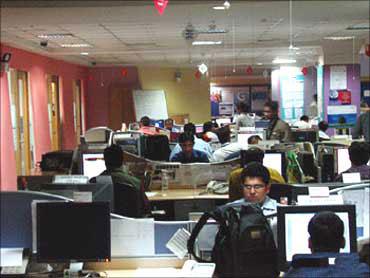Piyali Mandal in New Delhi
When Aegis, the Essar group's business process outsourcing arm, announced a 250-seater centre in Srinagar in 2010, it raised the eyebrows of many peers.
Two years after, the centre has added another 500 employees and been able to attract clients looking for capabilities and expertise in the local languages.
Aegis is not the only BPO firm in India setting shop in smaller towns.
Genpact, WNS, Hinduja Global Services, Firstsource, Aditya Birla Mincas and others have done the same.
. . .
Destination smaller towns for BPOs
With an expanding domestic market, increasing cost and higher attrition rate, outsourcing action is shifting to tier-III and IV cities.
According to a report by research firm KPMG, "a number of information technology and BPO companies are opening centres in these places to reduce operational expenditures.
"These smaller cities offer advantages such as availability of talent at a lower cost, low attrition rate, affordable real estate, local government support, and a better quality of life.
Analysts agree that by taking operations to a tier-III city, a company can save up to 30 per cent cost.
. . .
Destination smaller towns for BPOs
A growing domestic market is also driving companies to open centres in tier-III cities, said Sangeeta Gupta, vice-president, Nasscom.
According to recent data, the Indian IT-BPO industry is expected to be $101 billion in 2011-12.
Of this, domestic IT-BPO revenue is expected to be $32 bn.
The telecom sector was been the first to tap BPOs for delivering services. Many others such as banking, insurance and retail are yet to outsource in a big way.
. . .
Destination smaller towns for BPOs
Attrition, talent pool
Apart from a definite cost benefit, a shift to smaller cities is also due to the fact that these centres experience lower attrition and thus reduce the cost of hiring and training.
The attrition rate even today in the BPO sector among large companies is 30-40 per cent.
"The wage cost in some tier-II and tier-III cities are the same. For example, the wage offered to an employee in Noida is almost the same to that offered in Lucknow.
"However, in the tier-III centres, the attrition level is low. So, we save on training and retention cost," said R Vaidyanathan, executive VP and head of the domestic business at Aegis BPO.
. . .
Destination smaller towns for BPOs
Aegis employs a little over 10,000 people in centres at Ahmedabad, Lucknow, Jamshedpur, Bhopal, Pune and Srinagar. It recently proposed a centre in Chhindwara, MP.
"Moreover, most of the tier-III centres are small. Managing a 100-seater centre is far easier than managing a 1,000-seater centre," added Gupta of Nasscom.
"Sridhar K, executive VP for strategic initiatives & head of India domestic business, HGS, also notes the employee break-even is faster in small towns.
"Break-even period is the minimum stipulated time for which an employee must be retained to recover the cost of training and incurred expenditure.
. . .
Destination smaller towns for BPOs
"This includes average salary, training cost, expenditure made on the employee, commission paid to recruiting agencies, and revenue generated by each employee.
"A company can achieve more employee break-evens in smaller cities compared to tier-I," he said.
The company has centres in Siliguri (500 seats), Durgapur (1,200 seats), Guntur (500 seats) and Nagercoil (450 seats).
A lot of educational centres are also coming up in smaller towns.
A significant number of engineering colleges are outside the tier-I cities.
. . .
Destination smaller towns for BPOs
Students graduating from the institutes offer excellent talent pool. More, the students are looking at it as a career option and not just a short-term job, said S Vishwanathan, manager-consulting at Zinnov.
Keshav R Murugesh, group CEO, WNS, said all kind of services can be delivered from all centres, be it in tier-I or tier-II and tier-III cities.
"In most companies, 40 to 50 per cent of employees have come to tier-I cities from tier-II and tier-III cities, in search of work. We believe the long-term philosophy will be of taking work to the people instead of the current model of taking people to where work is," he said.
. . .
Destination smaller towns for BPOs
Image: A worker carries a new computer terminal to an office.Photographs: Jayanta Shaw/Reuters
Home growth
According to Nasscom Strategic Review 2012, the domestic IT-BPO market is expected to grow 17 per cent to reach Rs 91,800 crore (Rs 918 billion) in FY2012.
The domestic BPO market is expected to reach Rs 14,900 crore (Rs 149 billion), driven by demand from voice-based services (local languages) and increased adoption by both traditional and emerging verticals, including the government.
Call centres, BFSI (banking, financial services and accounting) and telecom will provide a $43-47 billion addressable opportunity for the Indian IT-BPO sector in the domestic market till 2020, according to Nasscom Perspective 2020, a study conducted by Nasscom and McKinsey.
. . .
Destination smaller towns for BPOs
It predicts call centre demand to have a compounded annual growth rate of 11 per cent till 2020.
"There is also the telecom story. With the penetration of telecom in the hinterlands, customer support is now being delivered from tier-III centres.
"It not only saves cost for the company, but also enhances customer experience," said Amneet Singh,VP, Everest Group. Companies prefer to serve the local market with services in the local dialect and accent. A lot of media companies are looking at content in regional languages, according to Zinnov Consulting.
. . .
Destination smaller towns for BPOs
Challenges
Moving to smaller cities will also allow companies to get better margins. Indian clients are price-sensitive; besides, firms will not have benefit of labour arbitrage as they have in global sourcing or exports.
Analysts note domestic pricing per FTE (full-time equivalent, a workload measure) is almost half that in the export segment, leading to lower margins.
More, margins are further impacted due to service tax on domestic revenue.
Among challenges it is again the people factor that is topmost.
Finding senior management prepared to move to these small cities is difficult.
. . .
Destination smaller towns for BPOs
"There's a shortage of competent managers to supervise the processes; senior experienced managers are reluctant to move to smaller cities. More, the physical infrastructure is evolving," added Sridhar.
Murugesh also points to the unavailability of reliable and fast network connectivity in rural areas as a challenge.
"IT/ITeS operations demand a high level of real time connectivity with many parts of the world. We believe all these obstacles can be overcome through a structured and a scientifically designed methodology," he said.













article